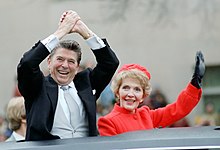
A self-clasping handshake is a gesture in which one hand is grasped by the other and held together in front of the body or over the head. In the United States, this gesture is a sign of victory, being made by the winning boxer at the end of a fight. [1] Leaders of the Soviet Union, such as Nikita Khrushchev, used the gesture to symbolise friendship when visiting the United States, and so risked misunderstanding. [2]
References
- ^ William Safire (November 10, 1985), "The Self-Clasping Squeeze", New York Times
- ^ Betty Jane Punnett (2012), International Perspectives on Organizational Behavior and Human Resource Management, M.E. Sharpe, p. 199, ISBN 9780765631107

A self-clasping handshake is a gesture in which one hand is grasped by the other and held together in front of the body or over the head. In the United States, this gesture is a sign of victory, being made by the winning boxer at the end of a fight. [1] Leaders of the Soviet Union, such as Nikita Khrushchev, used the gesture to symbolise friendship when visiting the United States, and so risked misunderstanding. [2]
References
- ^ William Safire (November 10, 1985), "The Self-Clasping Squeeze", New York Times
- ^ Betty Jane Punnett (2012), International Perspectives on Organizational Behavior and Human Resource Management, M.E. Sharpe, p. 199, ISBN 9780765631107